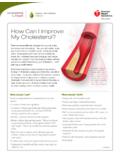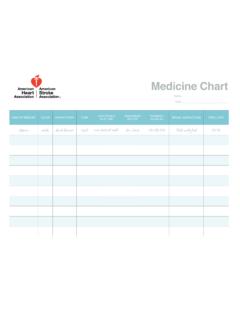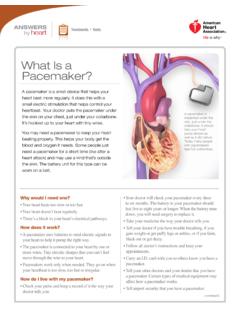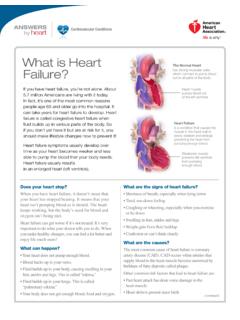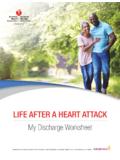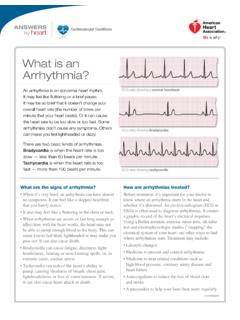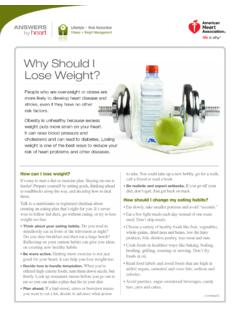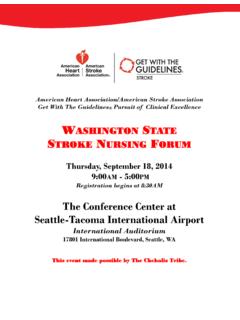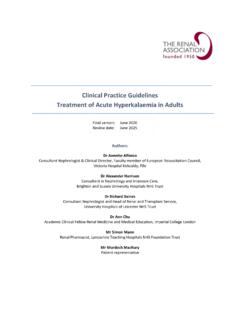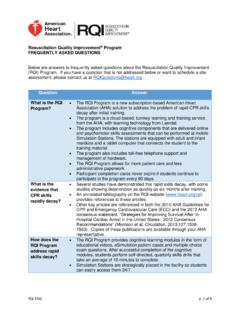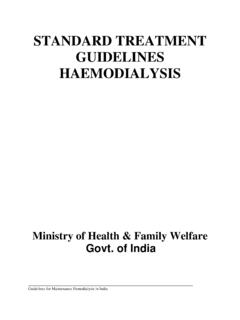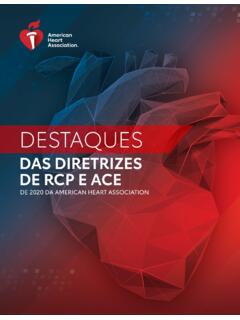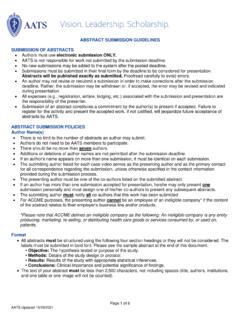Transcription of 2010 American Heart Association Guidelines for ...
1 2010 American Heart Association . All rights American Heart Association Guidelines for Cardiopulmonary Resuscitation and Emergency Cardiovascular Care Presenter Name 2010 American Heart Association . All rights <INSERT Any Relationships with Industry over the preceding 12 months here. If in doubt, report it.> Note that some treatments (eg, therapeutic hypothermia, amiodarone for pediatric cardiac arrest) in AHA Guidelines are not approved by US FDA. 2010 American Heart Association . All rights of AHA Guidelines for CPR and ECC Accessible to all users on the world-wide web (2005 Guidelines accessed more than million times) Provides science-based recommendations for resuscitation Adopted by other resuscitation councils and/or health ministries. Incorporated into protocols and practice Basis for AHA training materials. 2010 American Heart Association . All rights Development Process2010 AHA Guidelines for CPR and ECC 2010 American Heart Association .
2 All rights Consensus on Resuscitation ScienceThe American Heart Association and other member councils of International Liaison Committee on Resuscitation (ILCOR) complete review of resuscitation science every 5 2010 American Heart Association . All rights : Mission Statement Review the international science and knowledge relevant to CPR and ECC Publish consensus statements on resuscitation science When possible, also publish treatment recommendations applicable to all member organizations around the world. Encourage coordination of guideline development and publication by its member organizations around the world. 2010 American Heart Association . All rights from Question to Task Forces formulate authors perform structured evidence evaluation (with help from experts), present to Task Forces debate, discuss, reach consensus, draft Editorial Board, Councils review consensus, provide input to writing obtains peer on Science develop Guidelines 2010 American Heart Association .
3 All rights Guidelines Must consider: Local factors and resources available Educational challenges Cost 2010 American Heart Association . All rights Guidelines Published Oct 2010 InternationalConsensusFeb 2010 ILCORM archOsakaILCORNovOrlandoILCORMayGhentILC ORM archSun CityEvidence Evaluation ReviewsILCORNovOrlandoILCORNovNew OrleansWorksheetsPosted2010 Consensus Timeline 2010 American Heart Association . All rights Guidelines Timeline2010 International Consensus on CPR & ECC Science ConferenceWriting Groups WrotePeer Reviews, RevisionDocument Production2010 AHA Guidelines PublishedFeb 1-4 Feb 5 May 10 May 11 July 29 Oct 18 2010 American Heart Association . All rights of Evidence and Recommendation ILCOR used numerical Level of Evidence (LOE) to rate individual studies in Consensus on Science ( , LOE 5) AHA uses Class of Recommendation and alphabetical LOE for each guideline recommendation ( , Class IIb, LOE B) Provides internal consistency with other AHA evidence-based Guidelines .
4 2010 American Heart Association . All rights Evidence Classification 2010 American Heart Association . All rights Evaluation Process 411 scientific evidence reviews on 277 topics 313 participants at 2010 Consensus Conference, (46% from outside US) COI questionnaires completed by all participants (802 collected and reviewed) Writing group members voted on each recommendation 2010 American Heart Association . All rights of Potential Conflicts COI information posted with worksheets on website Industry employees excluded No industry support accepted for C2005 or C2010 COI for each speaker projected during meetings COI printed in C2010 program and final Guidelines publication COI questionnaires completed by all participants 2010 American Heart Association . All rights Publications 2010 International Consensus on CPR and ECC Science with Treatment Recommendations 2010 AHA Guidelines for CPR and ECC 2010 American Heart Association .
5 All rights ILCOR 2010 International Consensus on CPR and ECC Science With Treatment Recommendations Simultaneously published in Circulationand Resuscitation Documented review of tens of thousands of peer-reviewed resuscitation studies. 2010 American Heart Association . All rights ILCOR 2010 International Consensus on CPR and ECC Science With Treatment RecommendationsPart 1: Executive SummaryPart 2: International Collaboration in Resuscitation SciencePart 3: Evidence Evaluation ProcessPart 4: Conflict of Interest Management Before, During and After the 2010 International Consensus ConferencePart 5: Adult Basic Life SupportPart 6: DefibrillationPart 7: CPR Techniques and DevicesPart 8: Advanced Life Support Part 9: Acute Coronary SyndromesPart 10: Pediatric Basic and Advanced Life SupportPart 11: Neonatal ResuscitationPart 12: Education, Implementation, and Teams (EIT)Part 13: First Aid 2010 American Heart Association .
6 All rights 2010 American Heart Association Guidelines for Cardiopulmonary Resuscitation and Emergency Cardiovascular Care 17 chapters published in Circulation Foundation for ECC training materials 2010 American Heart Association . All rights American Heart Association Guidelines for CardiopulmonaryResuscitation and Emergency Cardiovascular Care SciencePart 1: Executive SummaryPart 2: Evidence Evaluation and Management of Potential or Perceived Conflicts of InterestPart 3: EthicsPart 4: CPR OverviewPart 5: Adult Basic Life SupportPart 6: Electrical TherapiesPart 7: CPR Techniques and DevicesPart 8: Adult Advanced Life Support Part 9: Post-Cardiac Arrest CarePart 10: Acute Coronary SyndromesPart 11: Adult StrokePart 12: Cardiac Arrest in Special SituationsPart 13: Pediatric Basic Life SupportPart 14: Pediatric Advanced Life SupportPart 15: Neonatal ResuscitationPart 16: Education, Implementation, and Teams (EIT)Part 17: First Aid 2010 American Heart Association .
7 All rights & ECC Guidelines Guidelines available online October 18, 2010 at 12:30 EDT. Printed Guidelines supplement published November 2, 2010 in Circulation. Can be downloaded free of charge at 2010 American Heart Association . All rights Changes2010 AHA Guidelines for CPR and ECC 2010 American Heart Association . All rights AHA Adult Chain of Survival New 5th link post-cardiac arrest care Links in the new adult Chain of Survival: Immediate recognition and activation of emergency response system Early CPR, w/emphasis on chest compressions Rapid defibrillation Effective advanced life support Integrated post-cardiac arrest care 2010 American Heart Association . All rights Sequence Change: From A-B-C to C-A- B Initiate chest compressions before ventilations Why? Goal: To reduce delay to CPR, sequence begins with skill that everyone can perform Emphasize primary importance of chest compressions for professional rescuers 2010 American Heart Association .
8 All rights Starts with Compressions Many adults with witnessed arrest have ventricular fibrillation (VF)/pulseless ventricular tachycardia (VT), and require chest compressions early defibrillation Chest compressions can be started immediately (no equipment needed) Opening airway, providing ventilation may significantly delay other actions Ventilation delayed by 18 seconds or less 2010 American Heart Association . All rights Emphasis on Chest Compressions All rescuers should, at a minimum, provide chest compressions. If bystander not trained (adult arrest): Hands-Only CPR If bystander trained and able: perform compressions and ventilations at rate of 30:2 Healthcare provider: perform compressions and ventilations at rate of 30:2 For all pediatric arrest, compressions and ventilations still recommended 2010 American Heart Association . All rights on Chest Compressions Why? Hands-Only CPR is easy to perform for adult victims and can be readily guided by EMS dispatchers over phone.
9 When all adult cardiac arrests reported, survival rates similar whether bystander provides Hands-Only CPR or traditional CPR. 2010 American Heart Association . All rights Algorithm for Adult CPR Traditional algorithm updated Alternative graphic provided All graphics emphasize importance of uninterrupted periods of CPR 2010 American Heart Association . All rights Chest Compression Depth Change: Compress at least 2 inches 2005 recommendation was 1 to 2 inches. Why? Compressions of at least 2 inches are more effective than those of 1 inches. Rescuers often do not push hard enough. Confusion may result when range of depth is recommended. 2010 American Heart Association . All rights Compressions Critical Without effective chest compressions Oxygen flow to brain stops. Oxygen flow to Heart stops. Drugs go nowhere. 2010 American Heart Association . All rights Compression Rate Change: Compression rate at least 100 per minute.
10 2005 recommendation: Compression rate about 100/min Why? Absolute number of compressions delivered/minute has been linked with survival. Actual compression rate is often well below 100/min. 2010 American Heart Association . All rights of Look, Listen, and Feel for Breathing Change: This action removed from the CPR sequence After delivery of 30 compressions, lone rescuer opens airway and delivers 2 breaths. Why? Rescuer checks for response and no breathing or no normal breathing in adult before beginning CPR Starting CPR with compressions minimizes delay to action 2010 American Heart Association . All rights reserved. 2010 American Heart Association . All rights Provider ADULT BLS Sequence Recognize unresponsive adult with no breathing or no normal breathing (ie, only agonal gasps) Activate emergency response, retrieve AED (or send someone to do this) Check for pulse (no more than 10 seconds) If no pulse, begin sets of 30 chest compressions and 2 breaths Use AED as soon as available 2010 American Heart Association .
